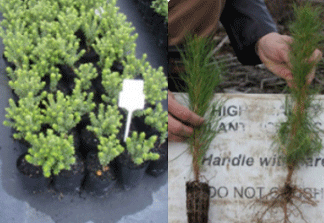Planting tree seedlings
Find out how to plant trees, and the pros and cons of different plant containers you can use when you source your seedlings.
On this page
How to plant seedlings
The most common way of planting trees is to use a purpose-designed planting spade. Seedlings need to be handled carefully to avoid damage to them.
The main factors affecting the quality of tree planting are:
- planter technique (skill)
- tree stock quality
- tree handling
- soil conditions
- slash cover
- vegetation cover
- terrain (slope)
- quality monitoring
- weather conditions.
The major factors contributing to poor planting are:
- planting hole not deep enough or wide enough
- trees not firmed in correctly
- inadequate soil cultivation
- incorrect planting depth
- no positive pull up to ensure the roots are correctly aligned
- poorly trimmed roots
- stem, root or collar damage to the seedling
- incorrect spacing
- poor planting site selection
- incorrect root and stem placement (roots bent up and stems not vertical).
Bare rooted seedlings
Bare rooted seedlings need to be planted so the roots spread downwards by:
- digging to 25 – 30cm deep
- planting them deeper than their final depth in a hole large enough to accommodate plant roots without them being curled up or bent at the bottom or sides of the hole
- doing a positive pull up before firming them in place.
Planting needs to be firm so the:
- roots have good contact with the ground
- root collar is slightly below ground.
Test by holding the top of the tree between 2 middle fingers and gently applying upwards pressure. If the tree seedling moves easily, it has not been planted firmly enough.
Container, planter bag or root trainer tree stock
The top of the tree mass needs to be just below the level of the surrounding soil. Soil should be firm around the root mass. This will make it easier for the tree roots to grow and reach the ground it has been planted in.

Positive pull up planting - bare rooted tree stock

Different plant containers
Open ground
Grown in prepared beds. Bare rooted plants lifted before delivery.
Advantages: Lower cost.
Disadvantages: Extra care required with transport and storage. Soil may compact around roots. Need good soil moisture and weed control.
Root trainers
Plastic containers that are hinged along the bottom, 4 plants per trainer. Vertical grooves to discourage spiral roots. Containers can be reused.
Advantages: Good root structure, little trimming. Low cost. Roots can be inspected. Easy to transport.
Disadvantages: Extra care required to avoid root damage when plant taken out of container. Small to medium plants need good weed control to overcome competition. Plants can be leggy with little lower foliage.
Planter bags
Black plastic bags, cylindrical root ball.
The higher the planter bag number, the more soil in the bag (measured in pints) and the bigger the plant.
Advantages: Bushier plants. Good height and root system. Easy to plant. May survive better in difficult sites.
Disadvantages: Roots tend to spiral and get tangled. Overgrown roots need trimming. Bulkier to transport. Higher cost per plant.
Pots (plastic) – olive pots
Rigid plastic pots. Good shaped root plug. Medium size plant with balanced foliage growth. Pots can be reused.
Advantages: Good balance between roots and vegetative growth. Easy to plant especially in difficult sites. Roots can be inspected without disturbance.
Disadvantages: Overgrown matted roots need trimming. Bulkier to transport. Medium size plants. Need good weed control.
Planter bags, root trainer and bare root

When to plant tree seedlings
The best times for planting seedlings is late autumn through to early spring.
If you need to delay planting trees on your site, there are some things you can do to help your seedlings survive.
How to plant videos and guidelines
Trees That Count have produced a video with tips on how to plant native trees and get your planting projects off to a great start.

Auckland Council has produced a video with tips for tree planting and how to prepare for a volunteer tree planting day.